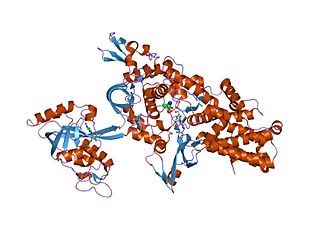
An aminoacyl-tRNA synthetase, also called tRNA-ligase, is an enzyme that attaches the appropriate amino acid onto its corresponding tRNA. It does so by catalyzing the transesterification of a specific cognate amino acid or its precursor to one of all its compatible cognate tRNAs to form an aminoacyl-tRNA. In humans, the 20 different types of aa-tRNA are made by the 20 different aminoacyl-tRNA synthetases, one for each amino acid of the genetic code.
In molecular biology, biosynthesis is a multi-step, enzyme-catalyzed process where substrates are converted into more complex products in living organisms. In biosynthesis, simple compounds are modified, converted into other compounds, or joined to form macromolecules. This process often consists of metabolic pathways. Some of these biosynthetic pathways are located within a single cellular organelle, while others involve enzymes that are located within multiple cellular organelles. Examples of these biosynthetic pathways include the production of lipid membrane components and nucleotides. Biosynthesis is usually synonymous with anabolism.
In enzymology, an alanine—tRNA ligase is an enzyme that catalyzes the chemical reaction
In enzymology, an asparagine-tRNA ligase is an enzyme that catalyzes the chemical reaction
Aspartate—tRNAAsn ligase is an enzyme with systematic name L-aspartate:tRNAAsx ligase (AMP-forming). This enzyme catalyses the following chemical reaction
Carnosine synthase is an enzyme that catalyzes the chemical reaction
In enzymology, a cysteine—tRNA ligase is an enzyme that catalyzes the chemical reaction
In enzymology, a D-alanine—poly(phosphoribitol) ligase is an enzyme that catalyzes the chemical reaction
In enzymology, a glutamine—tRNA ligase is an enzyme that catalyzes the chemical reaction
In enzymology, a lysine—tRNA ligase is an enzyme that catalyzes the chemical reaction

In enzymology, a phenylalanine—tRNA ligase is an enzyme that catalyzes the chemical reaction
In enzymology, a proline—tRNA ligase is an enzyme that catalyzes the chemical reaction
In enzymology, a serine—tRNA ligase is an enzyme that catalyzes the chemical reaction
In enzymology, a tryptophan-tRNA ligase is an enzyme that catalyzes the chemical reaction
Tyrosine—tRNA ligase, also known as tyrosyl-tRNA synthetase is an enzyme that is encoded by the gene YARS. Tyrosine—tRNA ligase catalyzes the chemical reaction
In enzymology, a lysyltransferase is an enzyme that catalyzes the chemical reaction
Amino acid activation refers to the attachment of an amino acid to its respective transfer RNA (tRNA). The reaction occurs in the cell cytosol and consists of two steps: first, the enzyme aminoacyl tRNA synthetase catalyzes the binding of adenosine triphosphate (ATP) to a corresponding amino acid, forming a reactive aminoacyl adenylate intermediate and releasing inorganic pyrophosphate (PPi). Subsequently, aminoacyl tRNA synthetase binds the AMP-amino acid to a tRNA molecule, releasing AMP and attaching the amino acid to the tRNA. The resulting aminoacyl-tRNA is said to be charged.

Alanyl—tRNA synthetase, mitochondrial, also known as alanine—tRNA ligase (AlaRS) or alanyl—tRNA synthetase 2 (AARS2), is an enzyme that in humans is encoded by the AARS2 gene.
Cyclodipeptide synthases (CDPSs) are a newly defined family of peptide-bond forming enzymes that are responsible for the ribosome-independent biosynthesis of various cyclodipeptides, which are the precursors of many natural products with important biological activities. As a substrate for this synthesis, CDPSs use two amino acids activated as aminoacyl-tRNAs (aa-tRNAs), therefore diverting them from the ribosomal machinery. The first member of this family was identified in 2002 during the characterization of the albonoursin biosynthetic pathway in Streptomyces noursei. CDPSs are present in bacteria, fungi, and animal cells.



